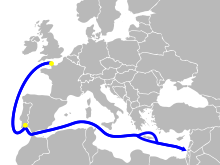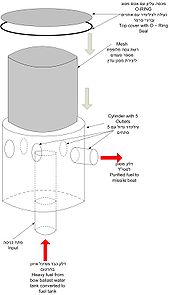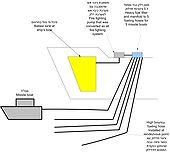- Cherbourg Project
-
The Boats of Cherbourg was an Israeli military operation which took place on 24 December 1969, and involved the escape of five class 3 missile boats from the French port of Cherbourg. The boats had been paid for by the Israeli government but had not been delivered due to the French arms embargo in 1969. The whole operation was planned by the Israeli Navy, and was codenamed "Noa-Operation", after the daughter of Captain Binyamin (Bini) Telem.[1]
Contents
Background
The Israeli naval command had come to the conclusion by the early 1960s that their old Second World War-era destroyers, frigates and corvettes were obsolete and new ships and vessels were needed. A survey was made and the German shipyard of Lürssen was recommended. The shipyard was asked to design a new generation of small missile boat platforms and to modify the suggested wooden Jaguar-class torpedo boats according to Israeli Navy requirements. However, due to Arab League pressure on the German government, this plan was not continued and a new builder was sought. The Israeli navy survey suggested that the Cherbourg-based Félix Amiot would build the boats, based upon the German planning and design. The boats and engines were German-designed, and constructed by the French. The project received the codename "Fall" (Autumn).
Navy crews were sent to France in early 1965. The technical team was headed by Commander Haim Schachal.[2] The administrative and operational side was headed by captain Binyamin (Bini) Telem, who later became a Rear Admiral and the navy's commander in chief during the Yom Kippur war.
This was during the "golden age" of relations between Israel and France. After the Six-Day War relations began to worsen. The French president Charles de Gaulle limited the export of weapons to Israel. In 1968 Israeli paratroopers commanded by Colonel Raphael Eitan (who later on became IDF chief of staff), carried out a raid on Beirut airport during operations against the Palestine Liberation Organization. As a result the French president Charles De Gaulle ordered a weapons embargo for any contract with Israel, even those that were ordered and paid by a contract.
With his moratorium declaration Charles de Gaulle cancelled the export license to Israel. However, he was afraid to cancel the working licenses of the shipyards due to riots sparked by recession and unemployment that had started in Paris. The French president did not want to escalate the situation by adding additional unemployment and feared public opinion and the spread of the riots throughout France.
The resignation of Charles de Gaulle and the election of Georges Pompidou to be the president of France inspired hope amongst the Israelis. The Israeli government assumed that Pompidou's close relation with the Rothschild family would cancel the embargo. They found out this was not to happen.
While the French government ordered a weapons embargo for Israel, they continued construction of the boats according to the original plan, and while the Israeli naval mission was in Cherbourg, controlling the project. Israeli crews were on board the completed boats and the whole project was fully paid for by Israel.
The build-up of the Egyptian Navy with Soviet assistance during the early days of the war of attrition and into the mid-sixties, and their procurement of new missile boats such as the Osa and Komar-classes, had changed the balance of power in the Mediterranean theatre in favour of Arab navies and away from the Israeli Navy. There was by now an urgent need for a new generation of vessels for the Israeli Navy. Israel had been developing seaborne missiles, but the new vessels they would be launched from were being built at Cherbourg. Their delivery to the Navy was considered a high priority.
The loss of the destroyer INS Eilat in an attack by Komar-class missile boats [3] in October 1967[4] and the accidental loss of the submarine INS Dakar in 1968, as well as the general ageing of the Israeli fleet, brought naval planners to the conclusion that the boats had to be taken from France by deception.
The Operation
Preparations
The plan to take the boats was formulated by retired Rear Admiral Mordechai 'Mokka' Limon, formerly the Israeli Navy's commander in chief, who was the head of the Israel Defense Forces mission in Paris. Limon's affiliation with the Rothschild family provided him with important connections in France with the French government, and more widely in Europe as well.
During that period, several events worked in favor of the Israelis. In 1967, the seventh boat of the 12 boats ordered, INS Mivtach (Reliance), was completed and launched. A telecom from Israeli Navy command informed the Israelis in Cherbourg that the embargo was expected to escalate, and the boat would have to sail immediately to Haifa during sea trials, ignoring the French protocols for leaving port. This angered the French, and they ordered the Israeli Navy and the other boats to leave the French Navy harbor, and dock instead at the commercial port, which was unguarded.
The boats were transferred to a front company called Starboat, registered in Panama. This company was a Norwegian company for oil drills. The front company was Limon's idea, aided by his connections with Milla Brenner, a retired naval officer with a rank of commander and the owner of the Israel-based "Maritime Fruit Carriers", a company which operated cargo ships transporting fruit. Milla Brenner knew the Norwegian businessman Martin Siem, who was able to provide assistance. The front company people were Mossad members led by Benyamin Vered, one of the highest ranking commanders of Mossad.
The front company feigned interest in the boats as potential survey ships for searching for oil, and declared that the boats' specifications met their needs. To add to the deception Limon pretended to have "tough negotiations " with Starboat. The terms agreed were that the boats would be transferred to Starboat and would be crewed by members of the Israeli Navy due to their experience with the boats. The boats were sold and transferred legally by the government of Israel to the front company with the approval of Michel Debré, the French minister of defence. This was the first part of the deception.
The next stage of the operation was to build a day-to-day routine with the aim of ultimately misleading the French at Cherbourg. The Israelis maintained a routine of short voyages, heading north into the Atlantic. Prior to the operation the Israeli crews were reinforced. Small groups of officers, ratings and sailors began to arrive at different destinations in France as tourists. The crews started to buy fresh and dry supplies from local grocery stores in small quantities each time in order to prevent the exposure of their plot. They made their purchases in small groups to avoid attention, since Cherbourg was a small town and the men were known there.
Prior the escape the boats had to be fuelled with large amount of fuel. Loading this fuel in one go would have alerted observers to the fact that a long voyage was planned. Commander Rinat, the head of operations, instead ordered the boats to the gradually fuelled using a small 5 ton tank truck. By 24 December the boats had been fully fuelled and stored.
Since sudden engine noise during the night of the escape would alert the French, the operation's commander, Captain Hadar Kimhi, ordered the boats' engines to be regularly started at nights, causing the inhabitants of Cherbourg to become accustomed to the noise. The local police visited the boats in response to inhabitants' complaints, and received the explanations that the electrical supply from the shore was not enough to warm the ship during the cold days of December. The boats received an authorization from the electrical company and police to operate their engines at night. The noise was loud since 20 Maybach main engines were running.
Meanwhile the ZIM navigation company Europe Lines were approached to help in providing fuel, once the boats had left Cherbourg. Assistance was provided by Edmond Wilhelm Brillant, a retired navy officer and a naval architect. He designated MV Lea [5] to provide fuel at Gibraltar and MV Natanya as a backup in the Bay of Biscay (both general cargo ships that were available at that time ). The main difficulty at this stage of the plan was the conversion of MV Lea into a fuelling ship. This was solved by conversion of the ballast tank in the ship's bow into a fuel tank. The pump system was converted to operate as both a fire fighting and fuelling pump. Special hoses with high buoyancy were used and a fuelling drill was developed prior sailing to the rendezvous point near Gibraltar. According to international maritime regulations, MV Lea could not sail since safety regulations ban ships from carrying fuel in the bow since fuel vapour might cause an explosion. This issue was solved by Brillant with the aid of Kirstine shipyards and a Lloyd's Register surveyor . The overall conversion and drill took 12 hours. Other Zim divisions provided the Dan, a Ro-Ro ship sister of MV Nili [6] which would provide fuel near Lampedusa. Captain of MV Dan was Yosef Dror, a retired Navy officer (Commander) and a Navy Seal.[7] In this case, tanker trailers were loaded in the ship's garage. These Zim ships sailed with additional crew made up of members of the Israeli Navy.
The escape
There was a force 9 storm on the night of the escape, but a report on the BBC indicated that the storm would die down. Faced with the decision of cancelling the mission or proceeding, Captain Hadar Kimhi gave the order to sail at 2AM.
The French were initially unaware that the Israeli boats had left port, and their absence was first noticed by a reporter who came to the port and saw that all the boats were missing. He immediately reported it to the BBC almost 12 hours after the escape and the French learned of it from BBC News.
The French were outraged and the French minister of defence Michel Debré ordered the French chief of staff to order an air strike and sink the boats. The French chief of staff refused to obey and replied he would resign rather than obey the order. The French prime minister Jacques Chaban-Delmas cancelled the order and prevented any further escalation. Although the French government were furious, they realized that there was little they could do, since the boats were already on the high seas when the ruse was uncovered. French Foreign Minister Maurice Schumann warned that if the boats appeared in Israel, "the consequences will be very grave indeed".
During fuelling by MV Lea at Gibraltar, one of the Israeli navy crew members mistakenly allowed water into the fuel tanks of INS Hetz (Arrow). It was not initially known whether the water was seawater, if it was it could not be drained and might damage the engines. Commander Rinat asked the crew to taste the fuel and to indicate if it was salty or not. Having determined that it was not seawater the tanks were drained.
The Israeli boats sailed a total of 3,145 nautical miles, beginning in the English Channel, and arriving at the Kishon Shipyard port [8] in Haifa bay on 31 December. When the boats approached the Israeli coast, they were given an escort of Israeli Air Force aircraft. The boats were met with public jubilation when they arrived in Israel.
The Navy's commander in chief during the operation was Rear-Admiral Avraham Botzer (Cheetah). The commanding officer of the operation was Captain Hadar Kimhi(later on Commodore commander of Haifa Navy-Base and Naval Attache in UK during the 1973 Yom Kippur War), with Commander Ezra Kedm Krishinski, nicknamed Karish (Shark) as his deputy (later on Commodore and commander of the Red Sea theatre ). The boats were:
- INS Suffa (Storm), skipper Lt. Ronna Arie
- INS Ga'ash (Volcano), skipper Lt. Gil Koren
- INS Herev (Sword), skipper Lt. Commander Gaddi Ben Zeev
- INS Hanit (Spear), skipper Lt. Commander Haim Shaked
- INS Hetz (Arrow), skipper Commander Moshe Tabak
Two young officers in the operation, Alex - Tal and Michael – Ram, went on to become commanders in chief of the navy.
The boats' names while being operated by the oil drilling company were Starboat 1,2,3,4,5. The boats joined the already acquired INS Sa'ar to form the Sa'ar 3-class missile boats.
International repercussions
The French government ordered the deportation of Mordechai Mokka Limon from France and declared him “persona non grata “. It was said that the French president stated “I do not like tea with Lemon and Mokka coffee”. Generals Louis Bonte and Bernard Gazelles were suspended by the government. The Cherbourg affair, together with Mossad's theft of the plans for the Mirage 3, which were used as a baseline for the design of IAI Kfir by Israel Aerospace Industries, ended a period of French-Israeli cooperation.[citation needed] Instead Israel turned to American supplies of weapons and support. The Israeli Air Force began to be equipped by US aircraft, while the US Navy started to train the Israeli Navy's high command and increased the level of naval cooperation.
Missile Boat Flotilla
The boats taken from Cherbourg were still unarmed platforms on their arrival in Israel. They were brought into the navy and armed with Gabriel missiles and ECM and EW systems produced by MABAT and RFAEL.[9] Their commissioning into the Israeli Navy was commanded by Commodore Yehoshua Lahave Schneidemesser, a Haganah member who had volunteered with the Royal Navy during the Second World War, and who was at the time the head of Navy – Equipment and Platforms.
The flotilla's working up was overseen by Captain Hadar Kimhi, who was later promoted to Commodore commanding the Naval base of Haifa. New concepts of sea missile warfare was developed by the navy and new ECM/EW techniques were developed with the leadership of Captain Herut Zemach[10] who was awarded the Israel Defense Prize for his efforts, sparking a new generation of missile boats. New Israeli Sa'ar boats were developed in Haifa Shipyards under the leadership of Haim Schachal, the chief engineer of the Israel Shipyards.[11] Two of the boats were launched a few months before the Yom Kippur War, INS Reshef (Flame, Spark) and INS Keshet (Bow), Sa'ar 4 class missile boats. For his leadership Schachal was awarded the Israel Defense Prize. The Israeli Navy went on to win the sea battles with the Egyptian and Syrian navies with zero casualties and losses. The Israeli Navy became a pioneer in modern sea missile warfare, resulting in their successes in the Yom Kippur war in 1973.
See also
Videos and Recordings
- Video of the boats arrival to Haifa and Charles De Gaulle's speech in the French TV and Israeli TV
- The Boats Story Press Conference of Georges Jean Raymond Pompidou French TV
- IDF Radio an interview with Mordechi Mokka Limon , start time 45:13 in Hebrew
- The Boats of Cherbourg Documentary
References
- Rabinovich The Boats of Cherbourg Bluejacket Books ISBN 1557507147 ISBN 978-1557507143
- Avi Brillant The Perfect Sting Magazin 13 January 2010 in Hebrew
- Moshe Levi The Escape of the Boats of Cherbourg Intreviews with Hadar Kimhi, Binyamin Telem and Rinat Arie Magazin 1 Feb 2007 in Hebrew
- The day the French learned about Israeli "hutzpa"
- Abraham Rabinovich Escape from Cherbourg Jerusalem Post Dec 24 2009
- Binyamin Vered and Mossad activity in Starboat Ha'aretz April 20th 2005
- The Spokesman-Review 29 December 1969
- "The last Battle of the Destroyer INS Eilat" by Commander Yitzhak Shushan". Ma’ariv Publishing House. 1993.
- plumbat affair
- Photos from Cherbourg and early days
- The Times Report on Cherbourg Escape 29-Dec-69
- American Jewish Yearbook 1970 Page 496
- TIME World: Israel's Fugitive Flotilla Monday, Jan. 12, 1970
- Edición del martes, 30 diciembre 1969, página 19
- Strategic Intelligence, Volume 1 By Loch K. Johnson page 77 ISBN 1931719276 ISBN 978-1931719278
Retrofits for Noa Operation
Categories:- 1969 in France
- 1969 in international relations
- 1969 in Israel
- Arms smuggling
- Conflicts in 1969
- France–Israel relations
- Israeli Navy
- Missile boats of the Israeli Navy
- Naval operations and battles
- Operations involving Israeli special forces
Wikimedia Foundation. 2010.






